
Home - Search - Browse - Alphabetic Index: 0- 1- 2- 3- 4- 5- 6- 7- 8- 9
A- B- C- D- E- F- G- H- I- J- K- L- M- N- O- P- Q- R- S- T- U- V- W- X- Y- Z
SSTL-70
 SSTL Microsatellite Credit: NASA |
AKA: CERISE;Healthsat;Kitsat;Microsat SSTL;MicroSat-70;MY-Sat;Posat;S80;Thai-Paht;Tiungsat;UoSAT. Status: Operational 1981. First Launch: 1981-10-06. Last Launch: 2001-09-30. Number: 17 . Payload: 25 kg (55 lb). Gross mass: 70 kg (154 lb).
SSTL used the MicroSat-70 platform for missions ranging from 50 to 70 kg total mass. It employed an adaptable, modular design capable of supporting a wide range of missions, with payloads of up to 25 kg.
Mechanically, the MicroSat-70 consisted of a stack of modular trays, containing all avionics and some of the payload electronics. These trays formed the mechanical structure of the spacecraft, providing a very efficient use of the internal volume. Above the main module stack was a payload bay dedicated to the mission payloads.
The MicroSat-70 was compatible with an extremely wide range of launch vehicles, and was successfully launched on Ariane-4, Zenit, Kosmos, Tsyklon, Athena and Dnepr.
Within its efficient, proven mechanical structure, the MicroSat-70 carried a customized complement of avionics selected from SSTL's extensive range of flight-proven systems. Typical avionics configurations featured dual redundancy of all key systems, with options for data storage, data processing and downlinking on various frequencies to meet mission requirements.
The platform could be configured for nadir pointing or inertial pointing missions, using momentum bias, zero bias, or gravity-gradient actuators.
The MicroSat-70 supported earth observation, communications and technology demonstration missions for civil and military use. It was available through the NASA Rapid Spacecraft Development Office catalogue for extremely rapid procurement by U.S. government agencies.
More at: SSTL-70.
| UoSat 3, 4, 5 (UO 14, 15, 22 / UoSAT-OSCAR 14, 15, 22) / Healthsat 1 Null |
| Kitsat 1, 2 (Uribyol 1, 2 / Kitsat-OSCAR 23, 25 / KO 23, 25) Null |
| Healthsat 2 / WavSat 1 Null |
| PoSAT 1 (POSAT-OSCAR 28, PO 28) Null |
| Cerise Caracterisation de l'Environnement Radioelectrique par un Instrument Spatiale Embarque; examined Earth RF environment. French government research payload incorporated into an advance microsatellite platform. Used the [SSTL-70] bus. |
| FASat Alfa, Bravo Earth observation, technology satellite built by SSTL for Fuerza ATra de Chile, Chile. Launched 1995 - 1998. Used the Microsat-70 bus. |
| TMSat 1 (TMSat-OSCAR 31, TO 31) / Thai-Paht 1 Null |
| Clementine ELINT ELINT, experimental satellite built by Alcatel Space (prime), SSTL (bus) for DGA, France. Launched 1999. Used the Microsat-70 bus. |
| Tsinghua 1 Technology satellite built by SSTL for Tsinghua University, China. Launched 2000. Used the Microsat-70 bus. |
| TiungSat 1 (MySat 1, Malaysian-OSCAR 46, MO 46) Null |
| Picosat American tether technology satellite. Picosat 7/Picosat 8 were ejected from the Mightysat II.1 satellite. The 0.25 kg satellites were connected by a 30 m tether and were deployed a year after launch. Experimental satellite built by SSTL for USAF STP (Space Test Program), USA. Launched 2001. Used the Microsat-70 bus. |
Family: Communications, Earth, Medium earth orbit, Sun synchronous orbit, Surveillance, Technology, Technology satellite. Country: UK. Spacecraft: Oscar, Athena Mars Flyby. Launch Vehicles: Thor, Delta, R-14, Kosmos 3, Tsiklon, Kosmos 11K65M, Tsiklon-3, R-36M 15A14, Delta 2310, Ariane, Delta 3920, Ariane 4, R-36M2 15A18M, Ariane 40, Ariane 42P, Athena-1, Zenit-2, Dnepr, Delta 2000, Delta 3000. Projects: Fasat, TMSAT. Launch Sites: Vandenberg, Baikonur, Plesetsk, Vandenberg SLC2W, Kourou, Plesetsk LC132/1, Baikonur LC109, Baikonur LC45/1, Kourou ELA2, Kodiak. Agency: Surrey. Bibliography: 2, 279, 296, 552, 554, 6.
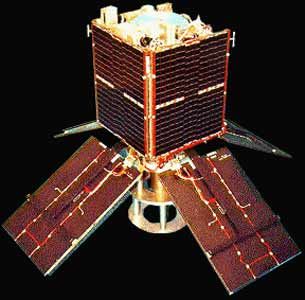 | CERISE Credit: Manufacturer Image |
 | Fasat-Alfa Credit: Manufacturer Image |
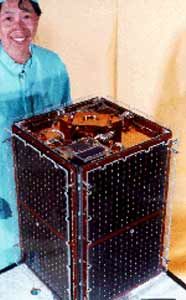 | Healthsat 2 Credit: Manufacturer Image |
 | Kitsat 1 Credit: Manufacturer Image |
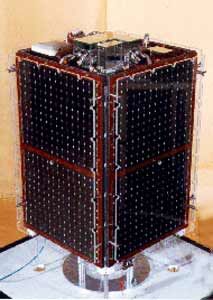 | Posat 1 Credit: Manufacturer Image |
 | Tiungsat-1 Credit: Manufacturer Image |
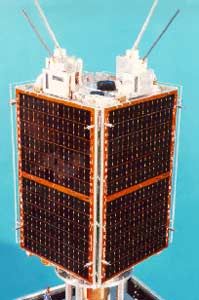 | TMSat 1 Credit: Manufacturer Image |
 | Tsinghua 1 Credit: Manufacturer Image |
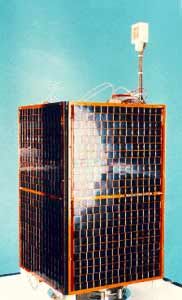 | Oscar 14 Credit: Manufacturer Image |
1981 October 6 - . 11:27 GMT - . Launch Site: Vandenberg. Launch Complex: Vandenberg SLC2W. LV Family: Thor. Launch Vehicle: Delta 2310.
- Oscar 9 - .
Payload: UoSAT 1. Mass: 52 kg (114 lb). Nation: UK.
Agency: Surrey.
Manufacturer: Surrey.
Program: Oscar.
Class: Communications.
Type: Amateur radio communications satellite. Spacecraft: SSTL-70.
Decay Date: 1989-10-13 . USAF Sat Cat: 12888 . COSPAR: 1981-100B. Apogee: 374 km (232 mi). Perigee: 372 km (231 mi). Inclination: 97.60 deg. Period: 92.00 min.
University of Surrey research microsatellite. Radio science; also carried amateur radio package. Communication and geophysics research satellite. Launch time 1127 GMT. Also registered by the United States in ST/SG/SER.E/59, with category D and orbital parameters 95.3 min, 531 x 533 km x 97.5 deg. UoSAT-OSCAR 9 was launched piggyback with Solar Mesosphere Explorer satellite. Weight 52 kg. Box shaped 740 x 420 x 420 mm. Deployable gravity gradient boom. Firsts: First on-board computer (IHU - Integrated Housekeeping Unit) for battery and attitude management, remote control, and experiments. Built by the University of Surrey in the United Kingdom, UO-9 was UoSAT's first experimental satellite. It was a scientific and educational low-Earth orbit satellite containing many experiments and beacons but no amateur transponders. UO-9 was fully operational until it re-entered October 13, 1989 from a decaying orbit after nine years of service.
1984 March 1 - . 17:59 GMT - . Launch Site: Vandenberg. Launch Complex: Vandenberg SLC2W. LV Family: Thor. Launch Vehicle: Delta 3920.
- Oscar 11 - .
Payload: UoSAT 2. Mass: 52 kg (114 lb). Nation: UK.
Agency: Surrey.
Manufacturer: Surrey.
Program: Oscar.
Class: Communications.
Type: Amateur radio communications satellite. Spacecraft: SSTL-70.
USAF Sat Cat: 14781 . COSPAR: 1984-021B. Apogee: 670 km (410 mi). Perigee: 651 km (404 mi). Inclination: 97.80 deg. Period: 98.00 min.
University of Surrey experimental microsatellite. Built in only 6 months, UoSAT-2 carried the first modern digital store and forward (S&F) communications payload and a prototype CCD camera. Also performed magnetospheric studies. Launch time 1759 GMT. Still operational in 2000.
1990 January 22 - . 01:35 GMT - . Launch Site: Kourou. Launch Complex: Kourou ELA2. LV Family: Ariane. Launch Vehicle: Ariane 40.
- Oscar 15 - .
Payload: UoSAT 4. Mass: 48 kg (105 lb). Nation: UK.
Agency: Surrey.
Manufacturer: Surrey.
Program: Oscar.
Class: Communications.
Type: Amateur radio communications satellite. Spacecraft: SSTL-70.
USAF Sat Cat: 20438 . COSPAR: 1990-005C. Apogee: 798 km (495 mi). Perigee: 784 km (487 mi). Inclination: 98.60 deg. Period: 100.70 min.
Technology demonstration mission carrying transponder, solar cell, CCD camera technology experiments. Customer: University of Surrey/European Space Agency. Launched alongside UoSAT-3, the microsatellite operated perfectly for 2 days before a failure occured in the downlink. Owner/operator University of Surrey, Dept of Electronic and Electrical Engineering, Guildford, Surrey GU2 5XH. Box shaped 350 x 350 x 650 mm. Four solar panels and 6 m gravity gradient boom.
- Oscar 14 - .
Payload: UoSAT 3. Mass: 46 kg (101 lb). Nation: UK.
Agency: Surrey.
Manufacturer: Surrey.
Program: Oscar.
Class: Communications.
Type: Amateur radio communications satellite. Spacecraft: SSTL-70.
USAF Sat Cat: 20437 . COSPAR: 1990-005B. Apogee: 797 km (495 mi). Perigee: 781 km (485 mi). Inclination: 98.60 deg. Period: 100.70 min.
University of Surrey experimental satellite. The first of Surrey Satellite Technology Ltd's modular microsatellites. Launched on the Ariane ASAP; carried an operational store and forward communications payload with extensive radiation monitoring experiments for SatelLife and Data Trax Inc (USA). Still operational in 2000. Owner/operator University of Surrey, Dept of Electronic and Electrical Engineering, Guildford, Surrey GU2 5XH.
1991 July 17 - . 01:46 GMT - . Launch Site: Kourou. Launch Complex: Kourou ELA2. LV Family: Ariane. Launch Vehicle: Ariane 40.
- Oscar 22 - . Payload: UoSAT 5. Mass: 50 kg (110 lb). Nation: UK. Agency: TUB. Manufacturer: Surrey. Program: Oscar. Class: Communications. Type: Amateur radio communications satellite. Spacecraft: SSTL-70. USAF Sat Cat: 21575 . COSPAR: 1991-050B. Apogee: 772 km (479 mi). Perigee: 759 km (471 mi). Inclination: 98.50 deg. Period: 100.20 min. Customer: SateLife. Carried store and forward communications and Earth observation payloads, replacing those lost on UoSAT-4. Still operational in 2000..
1992 August 10 - . 23:08 GMT - . Launch Site: Kourou. Launch Complex: Kourou ELA2. LV Family: Ariane. Launch Vehicle: Ariane 42P.
- S80/T - .
Mass: 50 kg (110 lb). Nation: France.
Agency: CNES.
Manufacturer: Surrey.
Class: Communications.
Type: Civilian communications satellite. Spacecraft: SSTL-70.
USAF Sat Cat: 22078 . COSPAR: 1992-052C. Apogee: 1,322 km (821 mi). Perigee: 1,308 km (812 mi). Inclination: 66.10 deg. Period: 111.90 min.
An industrial research microsatellite built by Surrey Satellite Technology Ltd (SSTL) for Matra and CNES to carry out 'Little LEO' communications service experiments. Still operational in 2000. S80/T was designed to investigate the technical feasibility of using a constellation of small satellites placed in near-Earth orbit to provide global communications and position location using only hand-held terminals. S80/T was the first fully commercial application of the SSTL multi-mission, modular microsatellite platform developed at the University of Surrey. The same basic platform was also used for the Korean KITSAT-A microsatellite, which accompanied S80/T into orbit on the same launch. The S80/T mission was completed, from concept to launch, within one year and SSTL delivered the platform, associated groundstation equipment and would be providing operations support during the mission within a contract of less than £1M.
- Oscar 23 - . Payload: Kitsat-A. Mass: 50 kg (110 lb). Nation: Korea South. Agency: KAIST. Manufacturer: Surrey. Program: Oscar. Class: Communications. Type: Amateur radio communications satellite. Spacecraft: SSTL-70. USAF Sat Cat: 22077 . COSPAR: 1992-052B. Apogee: 1,322 km (821 mi). Perigee: 1,310 km (810 mi). Inclination: 66.10 deg. Period: 111.90 min. Korean's first satellite achieved via a technology transfer programme with Surrey Satellite Technology Ltd. Carried store and forward communications, DSP and Earth observation payloads. Still operational in 2000..
1993 September 26 - . 01:45 GMT - . Launch Site: Kourou. Launch Complex: Kourou ELA2. LV Family: Ariane. Launch Vehicle: Ariane 40.
- Healthsat 2 - .
Mass: 48 kg (105 lb). Nation: USA.
Agency: Satelife.
Manufacturer: Surrey.
Program: Oscar.
Class: Communications.
Type: Amateur radio communications satellite. Spacecraft: SSTL-70.
USAF Sat Cat: 22827 . COSPAR: 1993-061E. Apogee: 803 km (498 mi). Perigee: 789 km (490 mi). Inclination: 98.70 deg. Period: 100.80 min.
Customer: SateLife. Store and forward communications satellite operating in the SatelLife 'HealthNet' LEO satellite communications network for remote regions. Still operational as of 2000.
Healthsat - II joined UoSAT-3/HealthSat-I as the second microsatellite in the HealthNet global communications system of SatelLife, a U.S. not-for-profit organisation. HealthNet, which was licensed in eighteen countries in Africa and Latin America, was providing desperately needed low cost 'last mile' communication links between medical institutions and health programmes in the developing world.
The HealthSat-II mission was completed, from concept to launch, within one year. SSTL were responsible for all the programmatic aspects of the mission including procuring the launch slot on the Ariane ASAP and arranging suitable insurance for the launch and early commissioning phase - all within a total contract price of £1M. Additional Details: here....
- Posat 1 - . Payload: Oscar 28. Mass: 50 kg (110 lb). Nation: Portugal. Agency: INETI. Manufacturer: Surrey. Program: Oscar. Class: Communications. Type: Amateur radio communications satellite. Spacecraft: SSTL-70. USAF Sat Cat: 22826 . COSPAR: 1993-061D. Apogee: 801 km (497 mi). Perigee: 789 km (490 mi). Inclination: 98.30 deg. Period: 100.80 min. Portugal's first satellite achieved through a technology transfer programme with Surrey Satellite Technology Ltd. Carried store and forward, DSP communications, GPS and Earth observation payloads. Still operational in 2000.. Additional Details: here....
1995 July 7 - . 16:23 GMT - . Launch Site: Kourou. Launch Complex: Kourou ELA2. LV Family: Ariane. Launch Vehicle: Ariane 40.
- CERISE - .
Mass: 50 kg (110 lb). Nation: France.
Agency: CNES,
DGA.
Manufacturer: Surrey.
Class: Communications.
Type: Amateur radio communications satellite. Spacecraft: SSTL-70.
USAF Sat Cat: 23606 . COSPAR: 1995-033B. Apogee: 675 km (419 mi). Perigee: 666 km (413 mi). Inclination: 98.10 deg. Period: 98.10 min.
Caracterisation de l'Environnement Radioelectrique par un Instrument Spatiale Embarque; examined Earth RF environment. Customer: Alcatel Espace/DME. French government research payload incorporated into an advance microsatellite platform. Still operational as of 2000.
1995 August 31 - . 06:49 GMT - . Launch Site: Plesetsk. LV Family: R-36. Launch Vehicle: Tsiklon-3.
- Fasat-Alfa - . Mass: 50 kg (110 lb). Nation: Chile. Agency: VKS. Manufacturer: Surrey. Program: Fasat. Spacecraft: SSTL-70. COSPAR: 1995-046xx. Apogee: 639 km (397 mi). Perigee: 605 km (375 mi). Inclination: 82.50 deg. Period: 97.20 min. Chile's first satellite built through a technology transfer programme with Surrey Satellite Technology Ltd. Carried store and forward and Earth observation payloads. Decommissioned as of 2000..
1998 July 10 - . 06:30 GMT - . Launch Site: Baikonur. Launch Complex: Baikonur LC45/1. LV Family: Zenit. Launch Vehicle: Zenit-2.
- TMSAT - .
Payload: Thai-Paht. Mass: 50 kg (110 lb). Nation: Thailand.
Agency: FACh.
Manufacturer: Surrey.
Program: TMSAT.
Class: Communications.
Type: Amateur radio communications satellite. Spacecraft: SSTL-70.
USAF Sat Cat: 25396 . COSPAR: 1998-043C. Apogee: 819 km (508 mi). Perigee: 816 km (507 mi). Inclination: 98.80 deg. Period: 101.20 min.
Customer: Thailand (Thai Microsatellite Company and MUT). Thailand's first microsatellite built through a technology transfer programme with Surrey Satellite Technology Ltd. Carried store and forward and Earth observation payloads. Still operational as of 2000. Additional Details: here....
- Fasat-Bravo - . Mass: 50 kg (110 lb). Nation: Chile. Agency: FACh. Manufacturer: Surrey. Program: Fasat. Class: Communications. Type: Amateur radio communications satellite. Spacecraft: SSTL-70. USAF Sat Cat: 25395 . COSPAR: 1998-043B. Apogee: 820 km (500 mi). Perigee: 815 km (506 mi). Inclination: 98.80 deg. Period: 101.30 min. Customer: Chilean Air Force (FACH). Chile's second satellite carrying store and forward and Earth observation payloads, replacing those lost on FASat-Alpha. Still operational as of 2000.. Additional Details: here....
1999 December 3 - . 16:22 GMT - . Launch Site: Kourou. Launch Complex: Kourou ELA2. LV Family: Ariane. Launch Vehicle: Ariane 40.
- Clementine - . Mass: 50 kg (110 lb). Nation: France. Agency: CNES, DGA. Manufacturer: Surrey. Class: Surveillance. Type: Naval signals intelligence satellite. Spacecraft: SSTL-70. USAF Sat Cat: 25978 . COSPAR: 1999-064B. Apogee: 616 km (382 mi). Perigee: 602 km (374 mi). Inclination: 98.10 deg. Period: 96.90 min. Customer: Alcatel Espace(France). French government military electronic intelligence research payload incorporated into an advance microsatellite platform. Based on CERISE with enhanced EMC subsystem. Still operational as of 2000..
2000 June 28 - . 10:37 GMT - . Launch Site: Plesetsk. Launch Complex: Plesetsk LC132/1. LV Family: R-14. Launch Vehicle: Kosmos 11K65M.
- Tsinghua - .
Mass: 50 kg (110 lb). Nation: China.
Agency: Tsinghua.
Manufacturer: Surrey.
Class: Technology.
Type: Navigation technology satellite. Spacecraft: SSTL-70.
USAF Sat Cat: 26385 . COSPAR: 2000-033B. Apogee: 713 km (443 mi). Perigee: 687 km (427 mi). Inclination: 98.14 deg. Period: 98.68 min.
Tsinghua University of Beijing satellite equipped with an imager, communications payload, and momentum wheels for 3-axis stabilisation. The 50 kg, 0.69 x 0.36 x 0.36m box-shaped satellite used a standard Surrey SSTL microsat bus.Tsinghua-1 was the first demonstrator for the planned Disaster Monitoring Constellation and carried a multi-spectral Earth imaging camera providing 39-metre nadir ground resolution in 3 spectral bands. The satellite also carried out research in low Earth orbit using digital store-and-forward communications, a digital signal processing (DSP) experiment, a Surrey-built GPS space receiver and a new 3-axis microsat attitude control experiment. Tsinghua-1 used the SGR-10, with 12 channels and equipped with two receive antennas, to investigate the use of GPS signals in microsat on-board attitude and orbit determination. In October 2000 Surrey Satellite Technology Ltd (SSTL) released a picture of Tsinghua-1 taken in orbit by the SNAP-1 6.5 kg nanosatellite.
2000 September 26 - . 10:05 GMT - . Launch Site: Baikonur. Launch Complex: Baikonur LC109. Launch Pad: LC109/95. LV Family: R-36M. Launch Vehicle: Dnepr.
- Tiungsat-1 - .
Payload: MY-Sat 1. Mass: 50 kg (110 lb). Nation: Malaysia.
Agency: BKSA.
Manufacturer: Surrey.
Class: Earth.
Type: Earth resources satellite. Spacecraft: SSTL-70.
USAF Sat Cat: 26545 . COSPAR: 2000-057A. Apogee: 658 km (409 mi). Perigee: 644 km (400 mi). Inclination: 64.56 deg. Period: 97.67 min.
Launch delayed from August 25/26. Customer: Astonautic Technology (M) SDN. BHD. Malaysia's first microsatellite built through a technology transfer programme with Surrey Satellite Technology Ltd Carried multi-spectral Earth imaging CCD cameras, meteorological Earth imaging CCD camera, digital store and forward communications, cosmic-ray energy deposition experiment (CEDEX)
2001 September 7 - . 19:39 GMT - . Launch Site: Vandenberg. Launch Complex: Vandenberg SLC8. LV Family: Minuteman. Launch Vehicle: Minotaur 1.
- Picosat 7/8 - .
Mass: 0 kg (0 lb). Nation: USA.
Agency: USAF AFSPC.
Class: Technology.
Type: Navigation technology satellite. Spacecraft Bus: SSTL-70.
Spacecraft: Picosat.
Decay Date: 2002-07-11 . USAF Sat Cat: 26929 . COSPAR: 2000-042C. Apogee: 286 km (177 mi). Perigee: 266 km (165 mi). Inclination: 97.80 deg. Period: 90.00 min.
Picosat 7/Picosat 8, were ejected from the Mightysat II.1 satellite on September 7 at 1939 UTC into a 511 x 539 km x 97.8 deg orbit. The 0.25 kg satellites were connected by a 30 m tether and were cataloged as a single object. Mightysat II.1 (Sindri) was launched in July 2000, and the deployment of the picosats was planned for a year after launch.
2001 September 30 - . 02:40 GMT - . Launch Site: Kodiak. LV Family: Athena. Launch Vehicle: Athena-1.
- Picosat - .
Mass: 67 kg (147 lb). Nation: USA.
Agency: USAF.
Manufacturer: Surrey.
Class: Technology.
Type: Navigation technology satellite. Spacecraft: SSTL-70.
USAF Sat Cat: 26930 . COSPAR: 2001-043B. Apogee: 795 km (493 mi). Perigee: 788 km (489 mi). Inclination: 67.00 deg. Period: 100.70 min.
STP P97-1 Picosat was built by Surrey Satellite for the USAF using a Uosat-type bus. The 68 kg satellite was to test electronic components/systems in space conditions. It carried four test payloads: Polymer Battery Experiment (PBEX), Ionospheric Occultation Experiment (IOX), Coherent Electromagnetic Radio Tomagraphy (CERTO) and an ultra-quiet platform (OPPEX). Called Picosat 9 by some Agencies although not related to other satellites in that series.
Back to top of page
Home - Search - Browse - Alphabetic Index: 0- 1- 2- 3- 4- 5- 6- 7- 8- 9
A- B- C- D- E- F- G- H- I- J- K- L- M- N- O- P- Q- R- S- T- U- V- W- X- Y- Z
© 1997-2019 Mark Wade - Contact
© / Conditions for Use